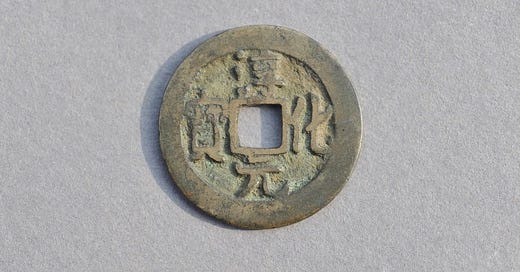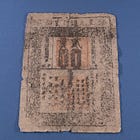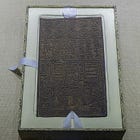The circulation of Song Dynasty coins on the Chinese land
How did the tiny copper coins cross the borders and connect the economic map of ancient China?
Liu Xian

Song Dynasty coins were not merely tools of trade but also catalysts for cultural integration. Due to the prosperity of the Song Dynasty, its coins became the universal medium of exchange in border trade with its various neighbors.
In 12th-century China, four political powers—the Song (960–1279), the Khitan Liao (907–1125), the Western Xia (1038–1227, established by Tangut), and the Jurchen Jin (1115–1234)—all vied for power. However, as the sun rose over the border trading posts and the air filled with the clicking of abacus beads and the jingling bells of camel caravans passing through the Hexi Corridor, a peculiar truce quietly took effect: neither the Khitan cavalry, the Tangut scimitars, nor the Jurchen arrows could prevent a tiny copper coin from crossing the borders.
This was the famous copper coin of the Song. Although minted in the copper foundries of the Northern Song Dynasty (960–1127), it circulated in Shangjing (present-day Chifeng city, Inner Mongolia autonomous region), the capital of the Liao, in Xingqingfu (present-day Yinchuan city, Ningxia Hui autonomous region) of the Western Xia, in Huiningfu (present-day Harbin city, Heilongjiang province) of the Jin, and even reached as far as the Kara-Khanid Khanate in Central Asia. Had Marco Polo been born two centuries earlier, he might have witnessed Persian merchants at the Samarkand bazaar muttering in their broken Chinese, "Song coins—the best coins around!"
Hidden treasure: The silent witness of copper coins
In 1909, Russian explorer Pyotr Kuzmich Kozlov unearthed a clay urn beneath the sands of Kara-Khoto, a Western Xia fortress in today’s Inner Mongolia. Inside, he found a large quantity of ancient coins, many of which were copper coins from the Northern Song Dynasty. This discovery, like a time capsule, unveiled a forgotten truth: despite ongoing warfare between the Western Xia and the Song Dynasty, the Western Xia people still valued Song coins as symbols of wealth.
The Western Xia, lacking copper mines, minted only a limited number of crudely-made coins, especially in its early stage. In contrast, Song coins were thick, well-proportioned, and had edges as sharp as new, allowing merchants to discern their quality simply by running their fingertips over them. Emperor Renzong of Western Xia even issued an edict mandating that Song coins should only be used for cross-border trade. Ironically, however, this decree inadvertently accelerated the infiltration of Song coins into the local economy. The Tangut aristocracy began to hoard Song coins, treating them like an "invisible vault" to be passed down through generations.
In addition, inscriptions on Song coins were predominantly in regular Chinese script, with well-formed strokes. In contrast, Western Xia coins inscriptions were mainly in the Western Xia script—a script derived from the strokes of regular Chinese characters but obscure to outsiders. Yet, in documents unearthed at Khara-Khoto, a ledger belonging to a Tangut merchant was recorded in Chinese characters, showing that despite the linguistic barriers, the language of wealth had long been unified.
Interestingly, in 1958, 107 copper coins were unearthed from a Liao tomb in Baiwanzhuang, on the western outskirts of Beijing. Among them, 98 were Song coins, while only 2 were Liao coins. In 1978, another hoard of 1,959 ancient coins was discovered in the Yaogou mound on Yunwu Mountain, Fengning Manchu Autonomous County, in Hebei province. Among them, 1,441 were Northern Song coins of more than 20 varieties, while only two Liao coins. Then in 1980, 6,383 coins were excavated in Dalianggou Village, Tumufuzhou Township, Baarin Left Banner, in Chifeng City, with Song coins accounting for 77 percent of the total. These findings indicate that Song coins held an absolutely dominant position in terms of circulation and savings during the Liao Dynasty; it is likely that the Liao nobility held large quantities of Song coins due to economic demands.
The Quechang: An "Economic Community" on the frontier
The Northern Song Dynasty was the most advanced society, in the world during its time, both economically and culturally. With superior coin-minting techniques and high-quality currency, Song coins became the universal medium of exchange in border trade with its various neighbors. These states "acquired coins from Song Dynasty, storing them in separate vaults as their national treasure."
The Song and Liao dynasties set up markets along their border, which were called Quechang, for the purpose of conducting commodity transactions. The Liao exported furs and livestock from their grasslands, while the Song provided silk and tea. However, the Liao people soon realized that it was more advantageous to directly accept Song coins rather than barter for goods as they could use these copper coins to purchase Qing salt (or, Celadon-colored rock salt) from the Western Xia, ginseng from Goryeo, and even Persian glassware from Uighur (Uygur) merchants. A single Song coin, proceeding like a messenger, tightly interlocked the economic gears of the Chinese land.
The Quechang markets were the officially sanctioned medium for cross-border trade in the Song Dynasty, yet undocumented folk trade between the Song and Liao peoples flourished to meet their daily needs.
The rise of Western Xia could have disrupted this balance. Controlling the Hexi Corridor, they imposed heavy taxes on passing caravans. However, the Tangut people soon realized that completely blocking the Silk Road would halt the circulation of Song coins and turn their hoarded wealth into worthless copper. Thus, while Western Xia cavalry continued raiding caravans, they tacitly permitted the passage of Song coins—a shrewd compromise.
Integration beneath the copper surface: How Song Coins reshaped identity
Song coins were not merely tools of trade but also catalysts for cultural integration. For nomadic tribes, these coins represented a symbol of power gentler than a warhorse.
In an attempt to promote its own "Jiaochao" (paper currency), the Jin Dynasty repeatedly accepted Song coins and other private copper coins, even forcing its people to exchange their coins for banknotes. However, it never succeeded in shifting the overwhelming demand for Song coins. This "currency loyalty" was, in essence, a silent endorsement by the people of an economic network that transcended political borders.
In the 13th century, the Yuan Dynasty brought an end to this era of competing regimes and established the first unified dynasty in Chinese history founded by an ethnic minority. Although the Yuan Dynasty prohibited the circulation of copper coins and adopted silver, silk, and other commodities as the basis for their paper currency system, this paper money (like the Zhongtong Baochao or Zhongtong Treasure Note) retained currency units such as "guan" (a unit of currency based on strings of coins) and "wen" (a single copper coin). This can be seen as a continuation of the Song Dynasty's paper currency system.
More profoundly, Song coins shaped an economic rationality that transcended ethnic boundaries. When Khitans used Song coins to purchase tea from Han people, when Tangut people exchanged Song coins for Persian glassware, and when Jurchens bought silk from southern region with Song coins, they unknowingly acknowledged that despite political turmoil, the interdependent coexistence of the Chinese nation remained endured.
Editor/ Liu Xian
Translator/ Deng Zhiyu
Related articles
Chief Editor/ Yang Xinhua
Coordination Editor/ Liu Xian
Reviewer/ Liu Li
Copyeditor/ Zhang Weiwei
Image Editor/ Tan Yujie
About DeepChina
DeepChina is an elite academic initiative that offers objective and rational analyses on a broad spectrum of topics related to China, encompassing politics, economics, culture, human rights, diplomacy, and geopolitics.





